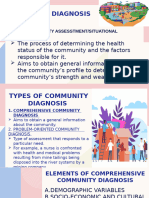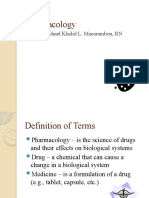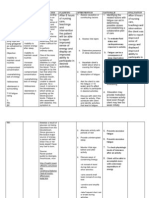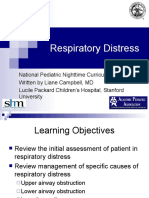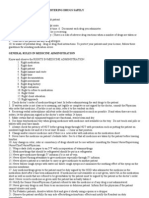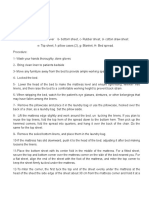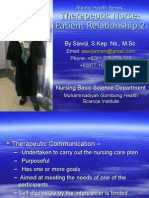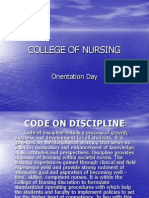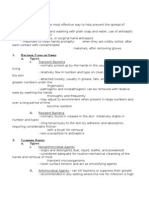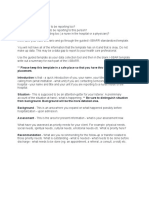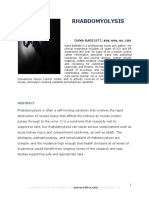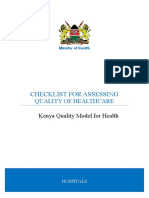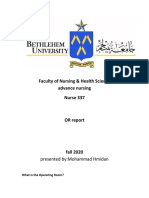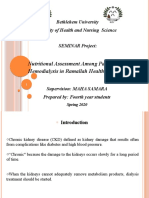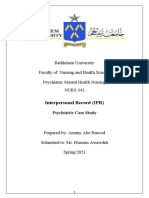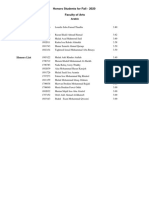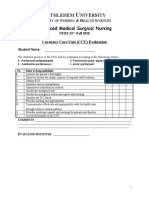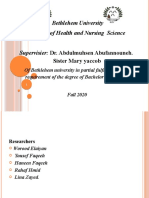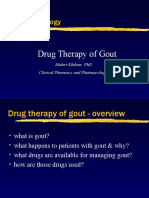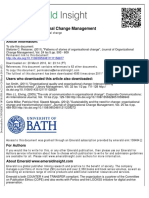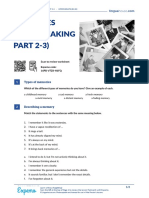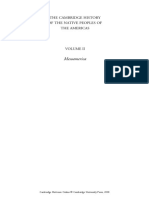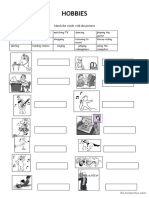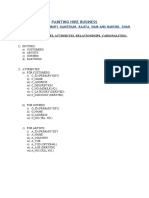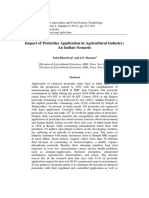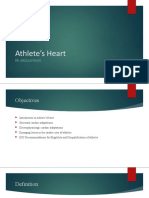0 ratings0% found this document useful (0 votes)
256 viewsPromoting Personal Hygiene & Promoting Rest & Sleep
Promoting Personal Hygiene & Promoting Rest & Sleep
Uploaded by
Yousef JafarThis document discusses personal hygiene and promoting rest and sleep. It defines hygiene, the integumentary system, and various hygiene practices like bathing, oral care, hair care, and nail care. It also discusses the importance of sleep, sleep phases like NREM and REM sleep, factors affecting sleep, and common sleep disorders like insomnia, hypersomnia, narcolepsy, sleep apnea, and restless leg syndrome. The nurse's role is to promote hygiene, comfort, and rest through environmental adjustments and relaxation techniques.
Copyright:
© All Rights Reserved
Available Formats
Download as PPT, PDF, TXT or read online from Scribd
Promoting Personal Hygiene & Promoting Rest & Sleep
Promoting Personal Hygiene & Promoting Rest & Sleep
Uploaded by
Yousef Jafar0 ratings0% found this document useful (0 votes)
256 views26 pagesThis document discusses personal hygiene and promoting rest and sleep. It defines hygiene, the integumentary system, and various hygiene practices like bathing, oral care, hair care, and nail care. It also discusses the importance of sleep, sleep phases like NREM and REM sleep, factors affecting sleep, and common sleep disorders like insomnia, hypersomnia, narcolepsy, sleep apnea, and restless leg syndrome. The nurse's role is to promote hygiene, comfort, and rest through environmental adjustments and relaxation techniques.
Copyright
© © All Rights Reserved
Available Formats
PPT, PDF, TXT or read online from Scribd
Share this document
Did you find this document useful?
Is this content inappropriate?
This document discusses personal hygiene and promoting rest and sleep. It defines hygiene, the integumentary system, and various hygiene practices like bathing, oral care, hair care, and nail care. It also discusses the importance of sleep, sleep phases like NREM and REM sleep, factors affecting sleep, and common sleep disorders like insomnia, hypersomnia, narcolepsy, sleep apnea, and restless leg syndrome. The nurse's role is to promote hygiene, comfort, and rest through environmental adjustments and relaxation techniques.
Copyright:
© All Rights Reserved
Available Formats
Download as PPT, PDF, TXT or read online from Scribd
Download as ppt, pdf, or txt
0 ratings0% found this document useful (0 votes)
256 views26 pagesPromoting Personal Hygiene & Promoting Rest & Sleep
Promoting Personal Hygiene & Promoting Rest & Sleep
Uploaded by
Yousef JafarThis document discusses personal hygiene and promoting rest and sleep. It defines hygiene, the integumentary system, and various hygiene practices like bathing, oral care, hair care, and nail care. It also discusses the importance of sleep, sleep phases like NREM and REM sleep, factors affecting sleep, and common sleep disorders like insomnia, hypersomnia, narcolepsy, sleep apnea, and restless leg syndrome. The nurse's role is to promote hygiene, comfort, and rest through environmental adjustments and relaxation techniques.
Copyright:
© All Rights Reserved
Available Formats
Download as PPT, PDF, TXT or read online from Scribd
Download as ppt, pdf, or txt
You are on page 1of 26
Promoting Personal Hygiene &
Promoting Rest & Sleep
Definition of Hygiene
• Hygiene means those practices that promote
health through personal cleanliness , such as
performing bathing , oral care , cleaning and
maintaining fingernails and toenails clean ,
hair shampoo , grooming hair also personal
hygiene can be through cleaning hearing aids ,
eye glasses and eye contact in order to
ensure proper functioning
What is the integumentary system
• Means the covering cover the surface of the
body and its opening include skin , mucous
membrane , hair , nails and teeth
• A-Skin : as you know consist of epidermis ,
dermis and the subcutaneous tissues
• Epidermis or outermost layer contains dead
skin cells that contains tough protein called
KERATIN
• Keratin protects the layers and structures
within the lower potions of the skin
• Dermis or true skin which contains most of the
secreted glands
• Subcutaneous layers separates the skin from
skeletal muscles , contains fat cells , blood
vessels , nerves and root of the hair follicles
and glands
• Function of the skin :
• Protect inner body structures from injury and
infection
• Regulate body temperature
• Maintain fluid and chemical balance
• Provide sensory information such as pain ,
temperature , touch and pressure
• Assist in converting to Vitamin D when
• exposed to sunlight
B-Mucous Membrane : Continuous with the
skin and line body passage such as the
digestive system , urinary , and reproductive
systems , also mucous membrane lines the
conjunctiva of the eyes , Goblet cells in the
mucous membranes secrete mucus , slimy
substances keeps membranes soft and moist
• C-Hair : made by Keratin ( Protein) , normal
distribution of the hair all over the body
except the sole and hands and depend on
male and female , infant , adult , and ethic
group
• Sebaceous gland in the hair follicles release
sebum an oily secretion that adds weight an
oily hair attract dust and debris
• D-Nails : Fingernails and toenails also made of
Keratin which gives them tough texture give
some protection to the digitals , normal nail
are thin , pink and smooth
• Change in the shape , color , texture ,
thickness and integrity of the nails provide
evidence of local injury or infection or disease
• E-Teeth : adults have 28 to 32 teeth , healthy
teeth are firmly fixed with the gums , any
inflammation of the gums called Gingivitis ,
normally teeth color is white but sometimes
changes occur due to coffee or tea , cigarette
or certain drugs and the integrity of the teeth
depends on the personal hygiene of the oral
care
Hygiene Practices : Through
• Bathing , in which the person uses cleansing
agent such as soap and water bathing ha s
several benefits are :
• Eliminating body odor
• Reducing the potential for infection
• Stimulating circulation
• Providing a refreshed and relaxed feeling
• Improving self-image
Types of Bathing
• tub bath or shower
• Partial bath : means washing only those body
area subject to greatest soiling or that sources
of body odor such as face , hands , axillae ,
genital area , can be done in the sink or with
the basin at the beside of the patient
• Bed bath : will be done in the lab with the care
for nails and genital area
Shaving & Oral Hygiene
• Shaving : means removes unwanted body hair
shaving done with electric or safety razor or
blade
• Oral Hygiene : Clean the mouth by using tooth
brush , tooth paste and dental floss
• Dentures : requires special care ( Explain)
Two types of Oral Hygiene
• 1-Assist the client with oral hygiene ( Explain)
• 2-Provide the client oral care for the
unconscious client
• Hair Care : practice in lab (Explain)
• Care for eyeglasses , contact lenses , hearing
aids…
Nursing Diagnosis related to Personal
Hygiene
• Self-care deficit , bathing/hygiene
• Self-care deficit dressing / Grooming
• Activity intolerance
• Risk for impaired skin integrity
Promoting Comfort , Rest & Sleep
• Definition of Comfort : is a state of reduce
physical activity for the purpose of
refreshment
• Definition of Sleep : is a state of rest in which
the person has an alternation of
consciousness
How we can promote comfort , rest &
sleep
• 1-The client environment : his/her room ,
room color , floor , lighting , ventilation , room
furnishing , privacy , chairs over bed table…
• 2-Sleep & Rest : Functions of SLEEP
• Reducing fatigue
• Stabilizing mood
• Improving blood flow to the brain
• Increasing protein synthesis
• Maintaining the disease-fighting mechanisms
of the immune system
• Promoting cellular growth and repair
• Improving the capacity for learning and
memory storage
• CIRCADIAN RHYTHMS : are Biological clocks ,
complete a full cycle every 24 hours
Sleep Phases
• Researches reveals that there are 2 major
stages of sleep
• 1-Non-Rapid Eye Movement (NREM)
• 2-Rapid Eye Movement (REM)
• (Discuss the photocopy)
Sleep Cycle
• Normally during sleep cycles a person passes
through 4 stages of sleep NREM , then there is
reversed from stage VI to stage III to stage to
stage II and instead of reentering stage I and
awaken the person enters into REM stage of
sleep then reenter to stage II , IV.. Awaken occurs
• Sleep Requirement : Requires 8 hrs of sleep to an
adult , Infant requires 14-20 and growing children
10-14 hrs of sleep
Factors affecting Sleep
• Nurses should be aware of the factors in order
to reduce or eliminate the cause :
• Light *Activity
• Environment *Motivation
• Emotions & Moods
• Food & Beverage
• Illness & Drugs
Common Sleep Disorder
• 1-Insomnia : Characterized by difficulty of
sleep , intermittent sleep , insomnia is the
more common sleep disorder most people
how suffers from insomnia are
• Older people
• History of depression
• Change from normal environment
• Stress
Signs & Symptoms of Insomnia
• Feeling tired
• Lethargic
• Irritable
• Difficulty to concentrate
• Treatment : Not necessary but if the insomnia
more than 3 to 4 weeks it is important to treat
the cause
• 2-Hypersomnia : is a condition characterized by
excessive sleep particularly during the day ,
work , while eating during conversation
• Causes are :
• Apnea *Certain drugs
• Drug abuse or alcohol
• Head trauma * Depression
• Some disease such as Multiple sclerosis epilepsy
• 3-Narcolepsy : is a condition characterized by
uncontrolled desire to sleep , fall asleep
during standing , driving a car , conversation ,
while swimming
• Narcolepsy start with adolescence and
adulthood and continue through the life
• 4-Sleep apnea : absence of sleep during sleep
for 10 to 20 second more may lead to brain
damage , sometimes may be due to
obstruction of tonsils or adenoid or sinus
• 5-Restless Leg Syndrome : Unpleasant
creeping in the calf or ankle or thigh
• Treatment : Eliminate caffeine , analgesic
drugs , apply hot water
• 6-Parasomina : is another type of disorder the
person may experience waking during the
night or grinding the teeth or taking or
nocturnal enuresis
• Nursing Implication for the sleep disorders :
• When the nurse is aware here we can apply
relaxation through different kinds of bed-
making and back rub or massage (In the Lab
explain types of bedmaking)
You might also like
- Copar 4Document63 pagesCopar 4El Sha VelascoNo ratings yet
- Feed Zone Cookbook Allen Lims Rice Cakes PDFDocument6 pagesFeed Zone Cookbook Allen Lims Rice Cakes PDFProdavamkokiceNo ratings yet
- Metglas 2605S3A HFADocument2 pagesMetglas 2605S3A HFAduc100% (1)
- SDMO Genset ManualDocument342 pagesSDMO Genset ManualVecherko Georgiy100% (2)
- Pharmacology: By: Jan Michael Khalid L. Macarambon, RNDocument164 pagesPharmacology: By: Jan Michael Khalid L. Macarambon, RNJan Macarambon100% (1)
- FatigueDocument3 pagesFatigueIande CornerNo ratings yet
- Respiratorydistress PresentationDocument18 pagesRespiratorydistress PresentationjerinthomasrajanNo ratings yet
- Operating Room ProcedureDocument6 pagesOperating Room ProcedureleviNo ratings yet
- Oleh: Nina Gartika, M.KepDocument41 pagesOleh: Nina Gartika, M.KepAgnisa HayatiNo ratings yet
- Anemia Anemia Describes The Condition in Which The Number of Red Blood Cells in The Blood Is Low. Probability & StatisticsDocument7 pagesAnemia Anemia Describes The Condition in Which The Number of Red Blood Cells in The Blood Is Low. Probability & StatisticsSahara GalayNo ratings yet
- AnemiaDocument2 pagesAnemiaLazeh MeNo ratings yet
- Routes of Drug Students)Document5 pagesRoutes of Drug Students)yabaeve100% (1)
- Course f2f Inp CPRDocument9 pagesCourse f2f Inp CPRMichelle Gliselle Guinto MallareNo ratings yet
- 01 Enteral and Parenteral Nutrition Support PSIK UMMDocument68 pages01 Enteral and Parenteral Nutrition Support PSIK UMMSri YulianaNo ratings yet
- Nursing Process: Claudette Mcgregor-Coombs, MSN, ArnpDocument63 pagesNursing Process: Claudette Mcgregor-Coombs, MSN, ArnpDanou_Bennett__828No ratings yet
- Fundamentals of Nursing PracticeDocument40 pagesFundamentals of Nursing PracticeLendell Kelly B. YtacNo ratings yet
- Adult Basic Safeguarding Awareness PresentationDocument28 pagesAdult Basic Safeguarding Awareness PresentationSARAHNo ratings yet
- Lifting Handling MovingDocument32 pagesLifting Handling MovingapriyaniNo ratings yet
- Ch.20 Heart and Neck VesselsDocument10 pagesCh.20 Heart and Neck VesselsJose R. MendozaNo ratings yet
- Hypovolemic ShockDocument13 pagesHypovolemic ShockJed ProwellNo ratings yet
- Latex AllergyDocument23 pagesLatex AllergyIsabel Barredo Del MundoNo ratings yet
- Prepared By: Sarah Diana Rise S. Manalili, RNDocument38 pagesPrepared By: Sarah Diana Rise S. Manalili, RNSARAH DIANA ROSE S. MANALILI100% (1)
- PARKINSON's DISEASE Nursing ManagementDocument67 pagesPARKINSON's DISEASE Nursing ManagementDr.Alan John N.ChandarNo ratings yet
- Nursing ProceduresDocument51 pagesNursing ProceduresLouella Mae CoraldeNo ratings yet
- 1st Lecture (NCM106 ABC I) Care of Clients in Cellular Aberrations, ABC, Emergency and Disaster NursingDocument14 pages1st Lecture (NCM106 ABC I) Care of Clients in Cellular Aberrations, ABC, Emergency and Disaster NursingKamx Mohammed100% (1)
- PWU NCM 114 - Care of The Older Person 3Document34 pagesPWU NCM 114 - Care of The Older Person 3Ira AnuddinNo ratings yet
- Asthma (Reactive Airway Disease)Document33 pagesAsthma (Reactive Airway Disease)anwar jabariNo ratings yet
- Percentages Exercise 1 - AnswersDocument36 pagesPercentages Exercise 1 - Answerskasonde.musonda8No ratings yet
- 01-Therapeutic Communication TechniquesDocument25 pages01-Therapeutic Communication TechniquesOliviaMirzaNuswantari100% (1)
- Why Is Cultural Knowledge Important To Nurses?: Cultural Competency in NursingDocument4 pagesWhy Is Cultural Knowledge Important To Nurses?: Cultural Competency in NursingFitriia SariiNo ratings yet
- Group 4 Pathologies of The Respiratory System Report MicroDocument54 pagesGroup 4 Pathologies of The Respiratory System Report MicroNapisa NajalNo ratings yet
- Legal Aspects of Nursing LEARNING OUTCOMES After Completing ThisDocument43 pagesLegal Aspects of Nursing LEARNING OUTCOMES After Completing Thistwy113100% (3)
- Hemorrhagic Cerebro Vascular DiseaseDocument37 pagesHemorrhagic Cerebro Vascular Diseasejbvaldez100% (1)
- Vital SignsDocument74 pagesVital SignsSofyan Hadi Saputra100% (1)
- 2 Infection ControlDocument34 pages2 Infection ControlMustapha S. MintehNo ratings yet
- Empyema ThoracisDocument33 pagesEmpyema ThoracisGracia EvangelistaNo ratings yet
- Code On Discipline 1Document17 pagesCode On Discipline 1Eric De TorresNo ratings yet
- Handwashing - PPEDocument14 pagesHandwashing - PPEdlneisha61100% (2)
- Psychiatric Nursing (Notes) : Alcohol AbuseDocument88 pagesPsychiatric Nursing (Notes) : Alcohol AbuseJulie Ann ParaNo ratings yet
- UNIT - 9 Digestive SystemDocument187 pagesUNIT - 9 Digestive SystemChandan ShahNo ratings yet
- Nursing Bullets: Fundamentals of Nursing ReviewerDocument44 pagesNursing Bullets: Fundamentals of Nursing ReviewerErl DiamanteNo ratings yet
- Fluid and Electrolytes CDocument112 pagesFluid and Electrolytes CJoyjoy FriasNo ratings yet
- OxygenationDocument56 pagesOxygenationHerald Clarence M. AmbayecNo ratings yet
- ANGINADocument33 pagesANGINAAnonymous mIw67bMXNo ratings yet
- Cerebrovascular Accident/Stroke: Rodney R. Reyes, RNDocument51 pagesCerebrovascular Accident/Stroke: Rodney R. Reyes, RNRodney ReyesNo ratings yet
- The Nursing ProcessDocument9 pagesThe Nursing Processiannello100% (2)
- Post OpDocument4 pagesPost OpLeo Paolo LuceroNo ratings yet
- Cellular AberrationDocument71 pagesCellular AberrationMichael CoronadoNo ratings yet
- Elderly ProblemsDocument4 pagesElderly ProblemsWilliam Ezekiel JUju CustodioNo ratings yet
- 4 Lesson 8 A Code of EthicsDocument42 pages4 Lesson 8 A Code of EthicsJiefontane Astor100% (1)
- Some Guiding thoughts-ISBARRDocument3 pagesSome Guiding thoughts-ISBARRBing Framo San JoseNo ratings yet
- Hypertension NotesDocument7 pagesHypertension Notesapi-3697326100% (3)
- Maternity Nursing 2Document133 pagesMaternity Nursing 2Rick100% (1)
- Newborn Essentials: A Parent's Guide to Best-Evidence Baby CareFrom EverandNewborn Essentials: A Parent's Guide to Best-Evidence Baby CareNo ratings yet
- Leaping the Hurdles: The Essential Companion Guide for International Medical Graduates on their Australian JourneyFrom EverandLeaping the Hurdles: The Essential Companion Guide for International Medical Graduates on their Australian JourneyNo ratings yet
- Healthcare Reflections, Insights, and Lessons: Proactive/ReactiveFrom EverandHealthcare Reflections, Insights, and Lessons: Proactive/ReactiveNo ratings yet
- Guidelines for Measuring Household and Individual Dietary DiversityFrom EverandGuidelines for Measuring Household and Individual Dietary DiversityNo ratings yet
- Rhabdomyolysis: Dana BartlettDocument35 pagesRhabdomyolysis: Dana BartlettYousef JafarNo ratings yet
- Multiple Choice Questions: B U F N & H S Comprehensive Exam Fall 2016 (B) Name: DateDocument14 pagesMultiple Choice Questions: B U F N & H S Comprehensive Exam Fall 2016 (B) Name: DateYousef JafarNo ratings yet
- Nursing Theorist Dorothea E. OremDocument33 pagesNursing Theorist Dorothea E. OremYousef JafarNo ratings yet
- Faculty of Nursing & Health SciencesDocument8 pagesFaculty of Nursing & Health SciencesYousef JafarNo ratings yet
- KQMH Hospital Checklist For Assessing Quality of CareDocument159 pagesKQMH Hospital Checklist For Assessing Quality of CareYousef Jafar100% (1)
- moath zaiter 4 واجبDocument9 pagesmoath zaiter 4 واجبYousef JafarNo ratings yet
- Faculty of Nursing & Health Science Advance Nursing Nurse 337Document18 pagesFaculty of Nursing & Health Science Advance Nursing Nurse 337Yousef JafarNo ratings yet
- Mood Disorder Depression and Bipolar DisorderDocument58 pagesMood Disorder Depression and Bipolar DisorderYousef JafarNo ratings yet
- Nutritional Assessment Among Patient With Hemodialysis in Ramallah Health ComplexDocument42 pagesNutritional Assessment Among Patient With Hemodialysis in Ramallah Health ComplexYousef JafarNo ratings yet
- Bethlehem University Faculty of Nursing and Health Science Psychiatric Mental Health Nursing NURS 342Document24 pagesBethlehem University Faculty of Nursing and Health Science Psychiatric Mental Health Nursing NURS 342Yousef JafarNo ratings yet
- Honors Fall 2020Document22 pagesHonors Fall 2020Yousef JafarNo ratings yet
- B U F N & H S N: Advanced Medical Surgical NURS 337 " Emergency Department Report "Document16 pagesB U F N & H S N: Advanced Medical Surgical NURS 337 " Emergency Department Report "Yousef JafarNo ratings yet
- Bethlehem University Faculty of Nursing and Health Science Psychiatric NursingDocument15 pagesBethlehem University Faculty of Nursing and Health Science Psychiatric NursingYousef JafarNo ratings yet
- Clinical EvaluationDocument13 pagesClinical EvaluationYousef JafarNo ratings yet
- Bethlehem University Faculty of Health and Nursing Science: Sister Mary YaccobDocument38 pagesBethlehem University Faculty of Health and Nursing Science: Sister Mary YaccobYousef JafarNo ratings yet
- Ccu Case Study: Prepared By: AMEER JAMHOURDocument26 pagesCcu Case Study: Prepared By: AMEER JAMHOURYousef JafarNo ratings yet
- Organization Organizational StructureDocument18 pagesOrganization Organizational StructureYousef JafarNo ratings yet
- ER Report: Prepared By: Ameer Jamhour - Submitted To: Mr. Jihad Ibhaes - University ID: 201604868 - NURS 337Document10 pagesER Report: Prepared By: Ameer Jamhour - Submitted To: Mr. Jihad Ibhaes - University ID: 201604868 - NURS 337Yousef JafarNo ratings yet
- Pharmacology: Drug Therapy of GoutDocument81 pagesPharmacology: Drug Therapy of GoutYousef JafarNo ratings yet
- Admission, Discharge, Transfer & ReferralsDocument31 pagesAdmission, Discharge, Transfer & ReferralsYousef JafarNo ratings yet
- Google Calendar How To Sync Any Desktop Calendar With Google CalendarDocument28 pagesGoogle Calendar How To Sync Any Desktop Calendar With Google CalendarGary Story100% (3)
- Patterns of Stories of Organisational ChangeDocument20 pagesPatterns of Stories of Organisational ChangeOmid XademNo ratings yet
- Introduction To InterviewsDocument13 pagesIntroduction To InterviewsNadia JasmineNo ratings yet
- Training Units: Simatic S7Document7 pagesTraining Units: Simatic S7chochoroyNo ratings yet
- Memories Ielts Speaking Part 2 3 British English Student Ver2Document2 pagesMemories Ielts Speaking Part 2 3 British English Student Ver2Mike PrestonNo ratings yet
- CIMA2020 - Priyanka GayenDocument8 pagesCIMA2020 - Priyanka GayenPriyanka GayenNo ratings yet
- Yale NUS CollegeDocument0 pagesYale NUS CollegeSherlita NurosidahNo ratings yet
- An Spss Case StudyDocument8 pagesAn Spss Case StudyVenkata Ramana MurthyNo ratings yet
- Rules For The Classification of Ships, Pt. 1, Ch.1, 2014Document29 pagesRules For The Classification of Ships, Pt. 1, Ch.1, 2014Suseprianus PatumbaNo ratings yet
- CH Native Peoples Americas Volume 2 Part 2 MesoamericaDocument457 pagesCH Native Peoples Americas Volume 2 Part 2 MesoamericaLorena GouveaNo ratings yet
- MAG Explorer Instructions TM7304 - R4Document39 pagesMAG Explorer Instructions TM7304 - R4Robert AguilarNo ratings yet
- NKBC: Andhra Pradesh: Annual Report 2018-19 Chapter-3Document2 pagesNKBC: Andhra Pradesh: Annual Report 2018-19 Chapter-3siva kumarNo ratings yet
- Shiva Enterprises: Marks and Nos, As Add Notify:Pls Inform To Consignee On Arrival (Doc Attached) NILDocument1 pageShiva Enterprises: Marks and Nos, As Add Notify:Pls Inform To Consignee On Arrival (Doc Attached) NILSathish JNo ratings yet
- Minute Maid Case StudyDocument2 pagesMinute Maid Case StudyEhab DanielNo ratings yet
- Hobbies and Can WorksheetsDocument6 pagesHobbies and Can WorksheetsMERCE AGUSTI IBARSNo ratings yet
- Simportal: Grid Portal For OpenseesDocument19 pagesSimportal: Grid Portal For OpenseesNaba Raj ShresthaNo ratings yet
- Painting Hire Business Case StudyDocument14 pagesPainting Hire Business Case StudyRajita NairNo ratings yet
- 1986 Landcruiser Maintenance ProceduresDocument40 pages1986 Landcruiser Maintenance ProceduresnapobNo ratings yet
- Impact of Pesticides Application in Agricultural Industry: An Indian ScenarioDocument6 pagesImpact of Pesticides Application in Agricultural Industry: An Indian Scenarioوهيب حسن الحذوريNo ratings yet
- MỞ RỘNG KIẾN THỨC SGK K12Document33 pagesMỞ RỘNG KIẾN THỨC SGK K12Lan Anh NguyễnNo ratings yet
- Daily Lesson Log FIRSTDocument17 pagesDaily Lesson Log FIRSTMajorica Cepeda MillanNo ratings yet
- Chapter 1-4Document65 pagesChapter 1-4MARVIN BALLENASNo ratings yet
- Athlete's Heart: Dr. Arzalan BaigDocument59 pagesAthlete's Heart: Dr. Arzalan BaigArzalan BaigNo ratings yet
- Lecture 5Document39 pagesLecture 5Ishtiaq AhmedNo ratings yet
- Final Research Changed2Document62 pagesFinal Research Changed2W SNo ratings yet
- CH 7 Atmosphere & Human ActivitiesDocument10 pagesCH 7 Atmosphere & Human ActivitiesAyanNo ratings yet
